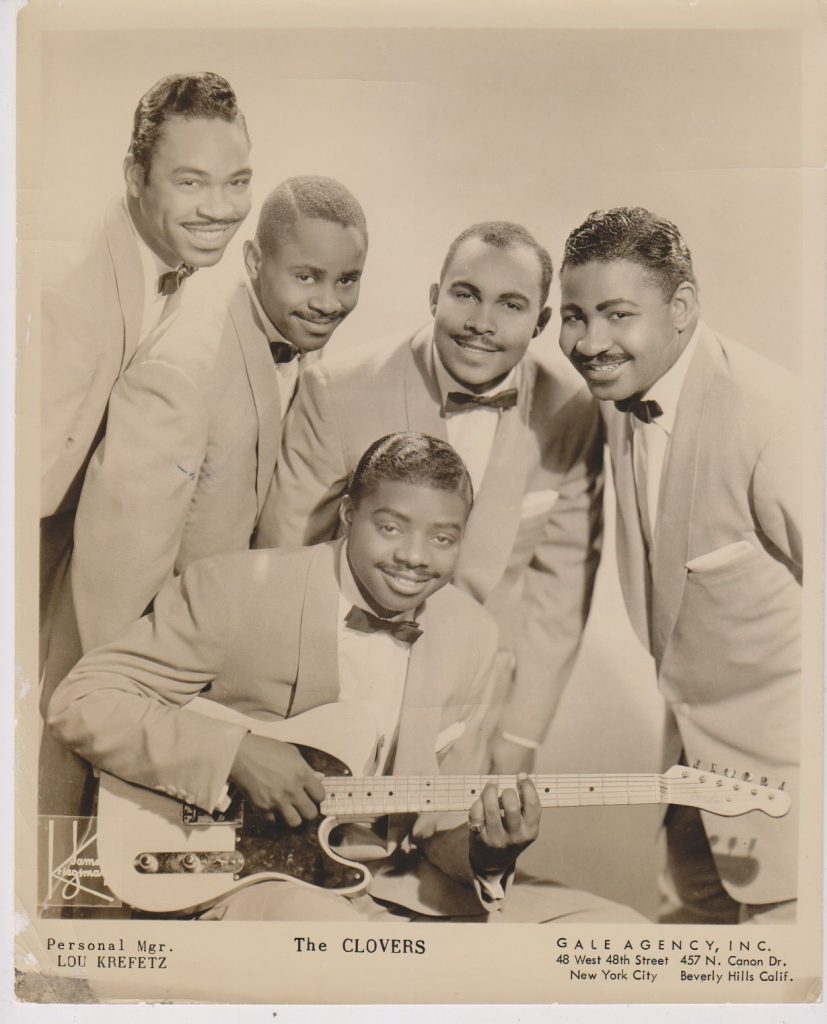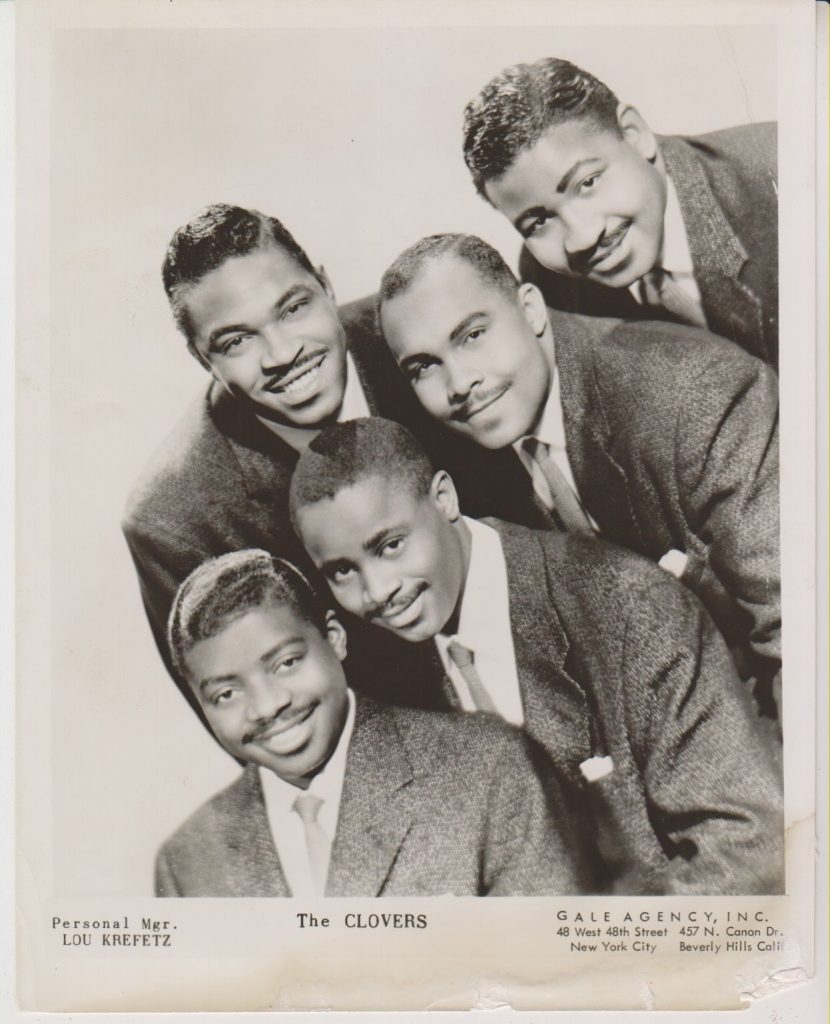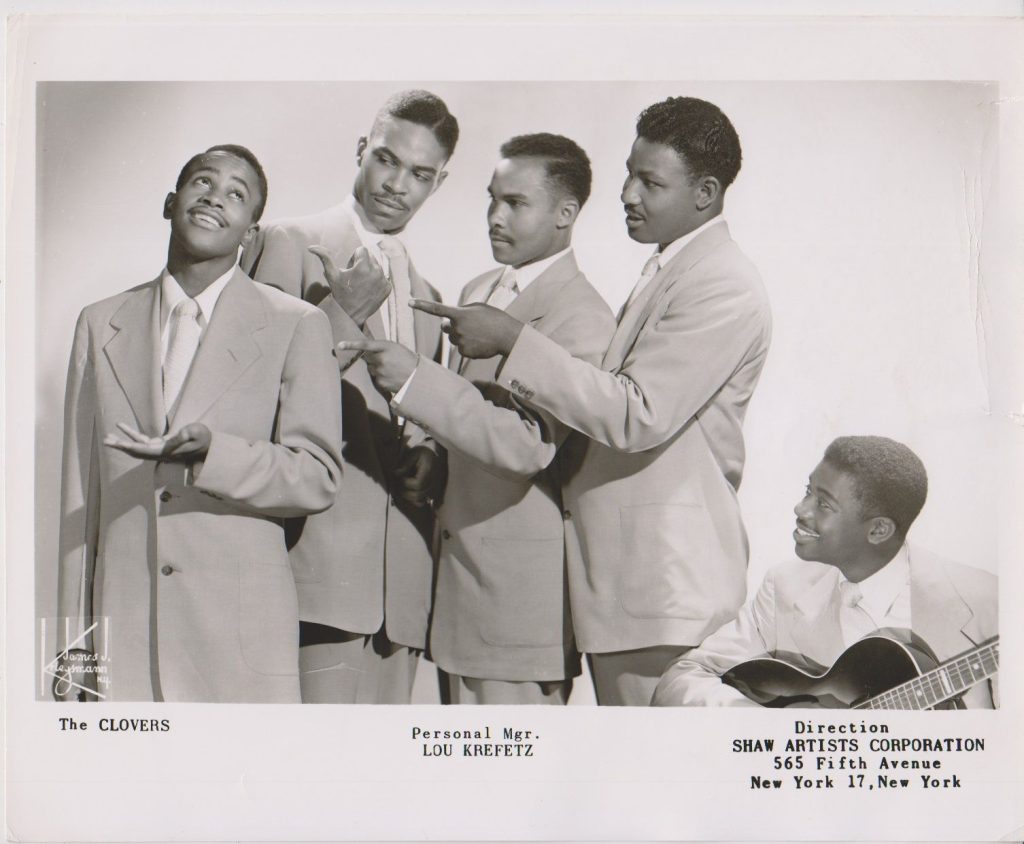EST. 1946
The Clovers
The Clovers formed at Armstrong Vocational High School in 1946, and became the most successful vocal group to hail from DC in the 1950's hands down. After a series of name changes and personnel rotations, the group solidified in 1950 with John 'Buddy' Bailey (lead tenor), Matthew McQuater (tenor), Harold Lucas (baritone), and Harold Winley (bass). Guitarist Bill Harris joined before their first session for Atlantic Records in February 1951. Bailey was drafted during August 1952, and Charlie White, formerly with The Dominoes, joined to replace him. When that arrangement came to an end, Washingtonian Billy Mitchell was asked to join the group. He remained when Bailey returned from Army service in May 1954.
The Clovers earned 21 R&B hits beginning in June 1951 with "Don't You Know I Love You," a No. 1 Billboard "Best Seller", and "Love Potion No. 9", a No. 3 R&B hit in December 1959. While The Clovers dominated the R&B charts in the early and mid-1950s, only two songs cracked the pop charts. One was the aforementioned "Love Potion No. 9"; the other was "Love, Love, Love", a Billboard Top 100 No. 30 hit from June 1956. Their first hits led to a string of national tours which didn't let up until the end of the decade.
The group originally followed the 1940s style of Washington vocal groups with a strong preference for popular standards sung in ballad style. Ahmet Ertegun, a co-founder of Atlantic records, was known to quip, "I had to teach The Clovers how to sing the blues." That comment leaves out the contributions of Artist & Repertoire Director, Jesse Stone; talented songwriters such as Rudy Toombs, Gladys DeJesus, and Tex Curtis; as well as recording engineer Tommy Dowd, who all contributed to The Clovers' transition to the top of the rhythm & blues charts for most of the decade.
The Clovers earned 21 R&B hits beginning in June 1951 with "Don't You Know I Love You," a No. 1 Billboard "Best Seller", and "Love Potion No. 9", a No. 3 R&B hit in December 1959. While The Clovers dominated the R&B charts in the early and mid-1950s, only two songs cracked the pop charts. One was the aforementioned "Love Potion No. 9"; the other was "Love, Love, Love", a Billboard Top 100 No. 30 hit from June 1956. Their first hits led to a string of national tours which didn't let up until the end of the decade.
The group originally followed the 1940s style of Washington vocal groups with a strong preference for popular standards sung in ballad style. Ahmet Ertegun, a co-founder of Atlantic records, was known to quip, "I had to teach The Clovers how to sing the blues." That comment leaves out the contributions of Artist & Repertoire Director, Jesse Stone; talented songwriters such as Rudy Toombs, Gladys DeJesus, and Tex Curtis; as well as recording engineer Tommy Dowd, who all contributed to The Clovers' transition to the top of the rhythm & blues charts for most of the decade.
One key element of that sound was the incorporation of bass pattern known as the skip bass, or Yancey bass, after Chicago pianist Papa Jimmy Yancey. It permeated their early blues songs for Atlantic and anytime you hear it reused by a later vocal group, you can know with some confidence that The Clovers were the inspiration.
The Clovers' predictable string of hit records, combined with those of Ruth Brown, another veteran of the Washington Nightclub scene of the late 1940's, provided the financial basis for Atlantic Records to thrive in the 1950's. The Clovers' influence on the music of the 1950's was undeniable, and echoes of their sound reverberated through the decade with Pop covers by Kay Starr ("Fool, Fool" Fool"), sound-a-like R&B groups such as The Topps and The Five Echoes, or Teen Idol recreations such as Bobby Vinton's "Blue Velvet", a Billboard Hot 100 No. 1 hit from 1963. The Clovers' early recordings such as "One Mint Julep," "Good Lovin', "Little Mama," and "Lovey Dovey" are considered iconic, yet the R&B audience of the early 1950's was simply not as large as the pop music audiences of the early 1960's, and those early hits were largely ignored by the oldies radio programming of the 1970's. That denied them the opportunity to cement their reputation among a new generation of fans.
The Clovers' predictable string of hit records, combined with those of Ruth Brown, another veteran of the Washington Nightclub scene of the late 1940's, provided the financial basis for Atlantic Records to thrive in the 1950's. The Clovers' influence on the music of the 1950's was undeniable, and echoes of their sound reverberated through the decade with Pop covers by Kay Starr ("Fool, Fool" Fool"), sound-a-like R&B groups such as The Topps and The Five Echoes, or Teen Idol recreations such as Bobby Vinton's "Blue Velvet", a Billboard Hot 100 No. 1 hit from 1963. The Clovers' early recordings such as "One Mint Julep," "Good Lovin', "Little Mama," and "Lovey Dovey" are considered iconic, yet the R&B audience of the early 1950's was simply not as large as the pop music audiences of the early 1960's, and those early hits were largely ignored by the oldies radio programming of the 1970's. That denied them the opportunity to cement their reputation among a new generation of fans.
The Clovers
Photo from bottom left Bill Harris, Harold Winley, Buddy Bailey, Matthew McQuater, and Harold Lucas (above diagonal)


